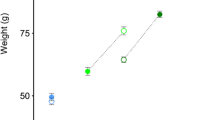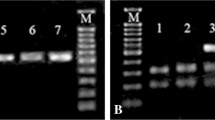Abstract
To determine the cytotype with better traits for the aquaculture practices of the dojo loach Misgurnus anguillicaudatus from the viewpoint of fish farming improvement, factorial crosses (2n♀ × 2n♂, 2n♀ × 4n♂, 4n♀ × 2n♂, 4n♀ × 4n♂) were conducted between natural diploids (D) and tetraploids (T), producing DD, DT, TD, and TT groups (female listed first). The potential benefits of the different cytotypes in culture were evaluated by comparing growth performance and survival rate for a 15-month rearing trial under the same production conditions. The average fertilization rate in DT and TT was significantly lower than in the DD and TD groups, possibly indicating the poor fertilizing capacity of the tetraploid sires. Survival rate in DT and TD was slightly lower than in DD but significantly higher than in the TT groups. Tetraploid females produced obviously larger eggs than diploids and, subsequently, significantly longer initial body length of TT and TD than DD and DT fry. However, from the second month of the growth trial, TT suffered higher mortality than other cytotypes, which significantly influenced morphometric growth parameters. The TD group exhibited superior growth performance throughout the experiment. The mean body length of DT was comparable with that of DD fish during the first 7 months but began to outgrow DD from the 9th month. This study suggests that the relatively better growth of tetraploid and higher survival rate of diploid can be integrated via inter-ploidy hybridization to get TD triploids with better culture traits.





Similar content being viewed by others
References
Arai K (2001) Genetic improvement of aquaculture finfish species by chromosome manipulation techniques in Japan. Aquaculture 197:205–228. doi:10.1016/S0044-8486(01)00588-9
Arai K (2003) Genetics of the loach, Misgurnus anguillicaudatus: recent progress and perspective. Folia Boil 51:107–117
Arai K, Matsubara K, Suzuki R (1991) Chromosomes and developmental potential of progeny of spontaneous tetraploid loach Misgurnus anguillicaudatus. Nippon Suisan Gakkai Shi 57:2173–2178
Arai K, Matsubara K, Suzuki R (1993) Production of polyploids and viable gynogens using spontaneously occurring tetraploid loach, Misgurnus anguillicaudatus. Aquaculture 117:227–235. doi:10.1016/0044-8486(93)90322-P
Arai K, Ikeno M, Suzuki R (1995) Production of androgenetic diploid loach Misgurnus anguillicaudatus using spermatozoa of natural tetraploids. Aquaculture 137:131–138. doi:10.1016/0044-8486(95)01106-4
Blanc JM, Chourrout D, Krieg F (1987) Evaluation of juvenile rainbow trout survival and growth in half-sib families from diploid and tetraploid sires. Aquaculture 65:215–220. doi:10.1016/0044-8486(87)90233-X
Cassani JR, Maloney DR, Allaire HP, Kerby JH (1990) Problems associated with tetraploid induction and survival in grass carp, Ctenopharyngodon idella. Aquaculture 88:273–284. doi:10.1016/0044-8486(90)90154-F
Felip A, Piferrer F, Zanuy S, Carrillo M (2001) Comparative growth performance of diploid and triploid European sea bass over the first four spawning seasons. J Fish Biol 58:76–88. doi:10.1111/j.1095-8649.2001.tb00500.x
Gao ZX, Wang WM, Khalid A, Zhou XY, Yang Y, Diana JS, Wang HP, Wang HL, Li Y, Sun YH (2007) Haematological characterization of loach Misgurnus anguillicaudatus: comparison among diploid, triploid and tetraploid specimens. Comp Biochem Physiol A 147:1001–1008. doi:10.1016/j.cbpa.2007.03.006
Goudie CA, Simco BA, Davis KB, Liu Q (1995) Production of gynogenetic and polyploid catfish by pressure-induced chromosome set manipulation. Aquaculture 133:185–198. doi:10.1016/0044-8486(94)00367-W
Guo X, DeBrosse GA, Allen SK Jr (1996) All-triploid Pacific oyster (Crassostrea gigas Thunberg) produced by mating tetraploids and diploids. Aquaculture 142:149–161. doi:10.1016/0044-8486(95)01243-5
Horstgen-Schwark G (1993) Initiation of tetraploid breeding line development in rainbow trout, Oncorhynchus mykiss (Walbaum). Aquacult Fish Manage 24:641–652
Kim DS, Jo YY, Lee TY (1994) Induction of triploidy in mud loach (Misgurnus mizolepis) and its effect on gonad development and growth. Aquaculture 120:263–270. doi:10.1016/0044-8486(94)90083-3
Kim DS, Nam YK, Park IS (1995) Survival and karyological analysis of reciprocal diploid and triploid hybrids between mud loach (Misgurnus mizolepis) and cyprinid loach (M. anguillicaudatus). Aquaculture 135:257–265. doi:10.1016/0044-8486(95)01031-9
Komaru A, Konishi K, Wada KT (1994) Ultrastructure of spermatozoa from induced triploid Pacific oyster Crassostrea gigas. Aquaculture 123:217–222. doi:10.1016/0044-8486(94)90060-4
Linhart O, Flajshans M, Kvasnicka P (1991) Induced triploidy in the common carp (Cyprinus carpio L.): a comparison of two methods. Aquat Liv Res 4:139–145. doi:10.1051/alr:1991014
Lou YD, Purdom CE (1984) Polyploidy induced by hydrostatic pressure in rainbow trout, Salmo gairdneri Richardson. J Fish Biol 25:345–351. doi:10.1111/j.1095-8649.1984.tb04881.x
Lutz CG (2001) Chromosomal genetics II: polyploidy. In: Practical genetics for aquaculture. Iowa State University Press, Ames, pp 141–161
Malison JA, Procarione LS, Held JA, Kayes TB, Amundson CH (1993) The influence of triploidy and heat and hydrostatic pressure shocks on the growth and reproductive development of juvenile yellow perch (Perca flavescens). Aquaculture 116:121–133. doi:10.1016/0044-8486(93)90003-H
Nam YK, Choi GC, Park DJ, Kim DS (2001) Survival and growth of induced tetraploid mud loach. Aquacult Int 9:61–71. doi:10.1023/A:1012540024333
Nam YK, Park IS, Kim DS (2004) Triploid hybridization of fast-growing transgenic mud loach Misgurnus mizolepis male to cyprinid loach Misgurnus anguillicaudatus female: the first performance study on growth and reproduction of transgenic polyploid hybrid fish. Aquaculture 231:559–572. doi:10.1016/j.aquaculture.2003.09.046
Park IS, Nam YK, Kim DS (2006) Growth performance, morphometric traits and gonad development of induced reciprocal diploid and triploid hybrids between the mud loach (Misgurnus mizolepis Günther) and cyprinid loach (Misgurnus anguillicaudatus Cantor). Aquacult Res 37:1246–1253. doi:10.1111/j.1365-2109.2006.01556.x
Schulz C, Gelbrecht J, Rennert B (2003) Treatment of rainbow trout farm effluents in constructed wetland with emergent plants and subsurface horizontal water flow. Aquaculture 217:207–221. doi:10.1016/S0044-8486(02)00204-1
Smith LT, Lemoine HL (1979) Colchicine-induced polyploidy in brook trout. Prog Fish-Cult 41:86–88. doi:10.1577/1548-8659(1979)41[86:CPIBT]2.0.CO;2
Solar II, Donaldson EM, Hunter GA (1984) Induction of triploidy in rainbow trout (Salmo gairdneri Richardson) by heat shock and investigations on early growth. Aquaculture 42:57–67. doi:10.1016/0044-8486(84)90313-2
Tiwary BK, Kirubagaran R, Ray AK (1997) Induction of triploidy by cold shock in catfish, Heteropneustes fossilis (Bloch). Asian Fish Sci 10:123–129
Valenti RJ (1975) Induced polyploidy in Tilapia aurea (Steindachner) by means of temperature shock treatments. J Fish Biol 7:519–528. doi:10.1111/j.1095-8649.1975.tb04627.x
Yamazaki F, Goodier J (1993) Cytogenetic effects of hydrostatic pressure treatment to suppress the first cleavage of salmon embryos. Aquaculture 110:51–59. doi:10.1016/0044-8486(93)90433-Y
Yin J, Zhao ZS, Chen XQ, Li YQ, Zhu LY (2005) Karyotype comparison of diploid and tetraploid loach, Misgurnus anguillicanudatus. Acta Hydrob Sin 29:469–472
Acknowledgments
This research is funded by the State Key Basic Research Project of China (973 projects) (no. 2009CB118706). This research is also a component of the AquaFish-ACRSP (Aquaculture Collaborative Research Support Program), supported by the US Agency for International Development (USAID).
Author information
Authors and Affiliations
Corresponding author
Additional information
Cytotype: individuals of the same species with different cytogenetic composition.
Factorial crosses: approach of producing offspring through inter-cytotype and intra-cytotype breeding with all possible crosses.
Rights and permissions
About this article
Cite this article
Zhou, X., Abbas, K., Li, M. et al. Comparative studies on survival and growth performance among diploid, triploid and tetraploid dojo loach Misgurnus anguillicaudatus . Aquacult Int 18, 349–359 (2010). https://doi.org/10.1007/s10499-009-9248-4
Received:
Accepted:
Published:
Issue Date:
DOI: https://doi.org/10.1007/s10499-009-9248-4




